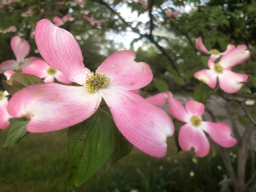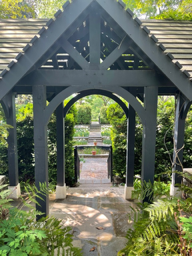A Peek into our Gardens
For this month’s blog post, I took a moment to speak with Joseph Day, our Head of Horticulture and Maintenance, about our magnificent gardens here at Agecroft Hall. Originally designed by Charles Gillette, one of the most renowned landscape architects in the South during the early 1900s (please see blog post here for more information), the horticulture department has a legacy to protect. When asked about his inspiration for the gardens, Joe seeks inspiration from Gillette gardens as well as gardens at English manor houses. The layout of the gardens has been relatively unchanged for almost 90 years, but that does not mean that the gardens have not changed in those nine decades since Agecroft was built on the banks of the James River in Richmond.
As the trees have matured, the shade they produce has changed what plant material can be planted where—what was once a bright, sunny spot is now shady and cool—well as cool as Virginia gets on a hot summer’s day! So now, instead of choosing plants that thrive in that bright sun, the horticulturalists now choose shade loving plants.
One area that is much different than Gillette’s original plans is our Sunken Garden. Designed to be reminiscent of the Sunken Garden at Hampton Court Palace, this garden, which boasts a beautiful tulip display every spring, was originally all green space, with no planting beds. While this change took place in the 1980s, Joe still tries to follow Gillette’s plans for the gardens, or, he looks for inspiration from English manor homes in the Elizabethan era to plant this garden space.
While the plant material may change year to year, Joe tries to keep the formal parts of the garden formal. Other planting areas have a much more ‘cottage garden’ type feel, creating an overall garden with many smaller spaces that each have their own feel, furthering Gillette’s love of creating outdoor “rooms” within a garden. Most recently we have added the Shakespeare Garden, in what was previously called the “Fountain Garden.” While the bones of this area of the garden did not change (i.e. the masonry is still there, the fountain that was here when Bessie Williams Morton lived in the house still burbles away, etc.), the overall feel of the space was changed by incorporating plants that are mentioned in Shakespeare’s plays.
One space in the garden where Joe thoroughly embraces our 17th century English heritage is the Tradescant garden (for more on the Tradescants, please click here). Here, he only plants plants that the Tradescants, both Elder and Younger, would have been familiar with, based on the meticulous records these men kept.
Spring is a beautiful time to come visit our gardens, but they are beautiful any time of the year that you may choose to visit us!
Many thanks to Joe Day for taking time during this busy season to help out with this post!--egh

















